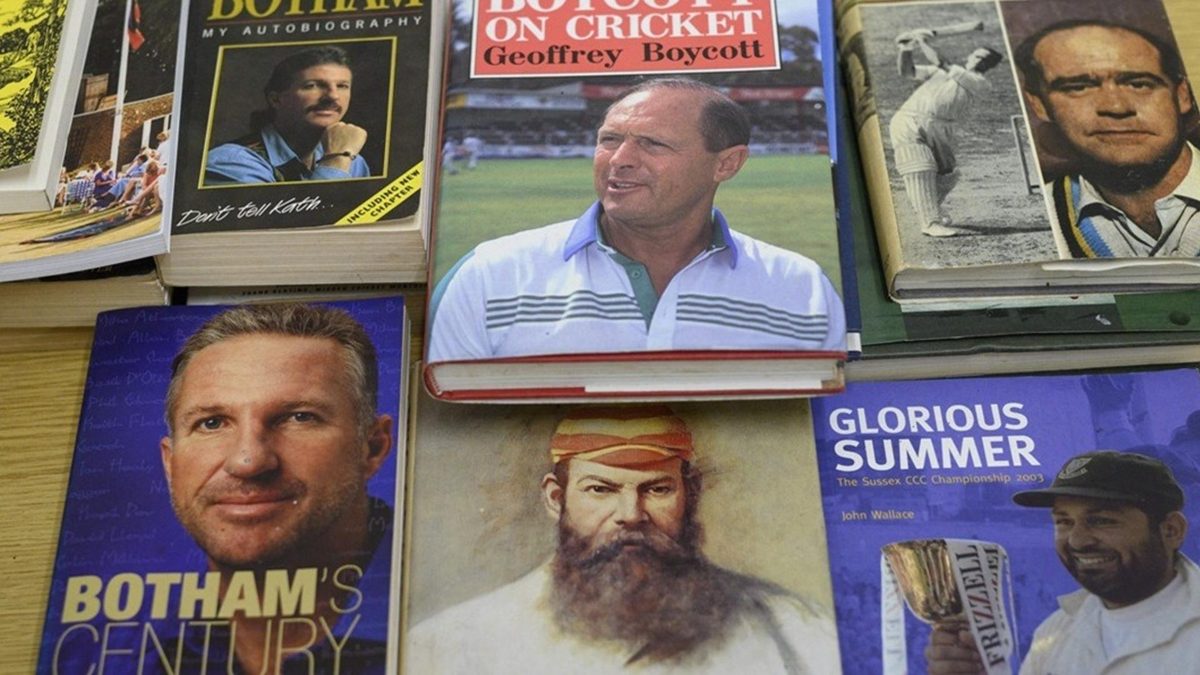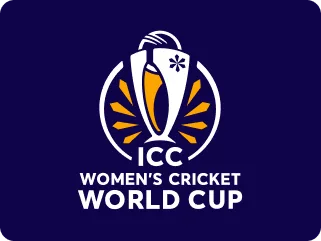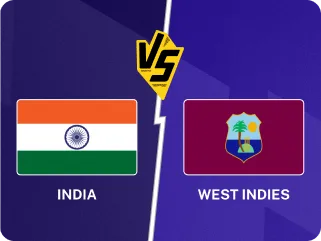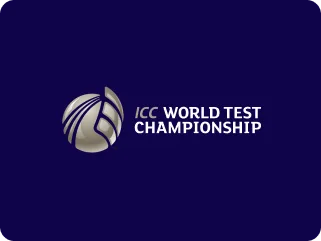
Wisden’s reviews of cricket books turned 75 this year. Jon Hotten’s piece on the subject originally appeared in the 2024 edition of the Wisden Almanack.
It began quietly, on page 971 of Wisden 1950, just after the list of Minor Counties fixtures for the bright new season ahead. “More than seventy books… stand before me,” writes John Arlott, before plunging in. He had begun a task, perhaps Sisyphean, that remained his until he died in 1991 (though Gordon Ross stepped in for two years). At a guesstimate, around 3,200 books passed under that increasingly rheumy, always gimlet eye. Since then, another 2,000-plus have come Wisden’s way. Books about cricket, it turns out, flow almost
as easily as runs from Bradman’s bat.
Arlott is one of those people it is hard to imagine being young, but he was 35 in 1949, still relatively new to the BBC, commentary and book reviewing. Even so, his description of the job, given in his second paragraph, remains unimpeachable: “The major problem facing the critic in his assessment of these books lies in their being directed to different sections of the public and, hence, having no common denominator of style, aim or method. This rules out all but the most limited comparative criticism and, simultaneously, demands a statement of the critical standard to be applied. Wisden is largely published for those interested in cricket and who, we may assume, will be to some extent sympathetic to almost any book on the game. For these readers, a cricket book must be accurate in its technical and statistical content. Indeed, such accuracy is an obvious prerequisite of the records and reports which every game has – as its original chronicles. But cricket has more: it has produced a body of minor but genuine art which is a vital ingredient in the unique character of the game.”
Thus armed, Arlott sets out to cross this ocean of book-time, an exercise in patience that marks him down as almost saintly, given some of the profoundly boring items with which he was annually confronted. Yet he retains his benevolence in the face of obscure club historians and hero-worshipping profilers, developing a series of wonderful euphemisms – “written in an unassuming style”… “enthusiastically written and subedited”… “another faithful piece of research” – to deal with the men (and it was always men) called to the typewriter for their shot at
immortality.
Equally, he is on the lookout for those sacral moments, found in “the vital fusion between craftsmanship and experience which is called art”. His reading goes back to Nyren and Pycroft, his twin pillars, and he seeks the same buzz in the new: “The books which achieve this fusion must be given recognition, for not only do they win respect for their subject, their quality will outlive their subject matter.”
He is right. The true test for the writer – and for the reviewer – is time. As a critic, you hope you recognise greatness when you see it, and are attuned enough to understand the moment, and to seize it. Arlott has to wait a while but, when that moment comes, he does not miss: “1963 has been marked by the publication of a cricket book so outstanding as to compel any reviewer to check his adjectives several times before he describes it, and since he is likely to be dealing in superlatives, to measure them carefully to avoid overpraise – which this book does not need.”
It is, of course, Beyond A Boundary, and it’s a thing of wonder to feel its impact on Arlott in real time. “To some it might not seem like a cricket book at all,” he writes. “The habitual reader… may be startled to find that Bernard Berenson, Matthew Arnold, Edmund Burke, John Milton, Michelangelo, Karl Marx and Charles Dickens have more index references than Tony Lock, Wesley Hall, Trevor Bailey…”
With C. L. R. James, cricket writing confronted modernity, then watched it float past. The sport’s anachronistic nature is reflected in its writing. Decades of moon landings and civil rights, three-day weeks and punk rock, fly by without touching the page. The summer of 1969, for example, finds Arlott knee-deep in JN Pentelow – A Biographical Enquiry (“another faithful piece of research”) and The Springbok and the Kangaroo (“thorough and enthusiastic”). The cricket books of 1973 “do not include a major work in any field”, while the arrival, in 1975, of Bill Frindall’s Scorebook feels like a glimpse of the space shuttle: “Of oblong, scorebook shape, and quite ingeniously contrived, it is based on the reproduction of the ball-by-ball scoresheets kept by Bill Frindall for each of the four Tests.”
A shift, though, is emerging. While the true cult of celebrity is a generation away, and tabloid obsession with the lives of players awaits the arrival of Ian Botham, big-name cricketers are sensing an opportunity, and publishers are finding a voice to help sell them. In 1976, Arlott comes across Fred Trueman’s Ball of Fire, a haircurlingly un-PC tell-all that caused scales to fall from my childhood eyes: “It’s an outspoken account of his often turbulent, but highly successful career…” By 1981, the summer after his final words in the Test Match Special box were applauded from the Lord’s crease by Geoffrey Boycott, Arlott is reading Life in the Fast Lane, Boycott’s account of his final tour of the West Indies: “his mind is completely independent; he flatters no one”. There’s also Frank Keating’s book of the same tour, Another Bloody Day in Paradise, whose vivid framing of Michael Holding’s over to Boycott in Barbados, followed by the shattering death of Ken Barrington that evening, proved deeply original: “In a way no other book has been, an intimate – in the best sense of the word – account of a party of cricketers.”
By 1985, Botham is perhaps the most famous sportsman in the land, and is the subject of two books, Keating’s High, Wide and Handsome and Peter Roebuck’s It Sort of Clicks. The connection between cricket and celebrity, and between celebrity and sales, is becoming a firm principle. Autobiographies by Boycott (“He has many critics, but every one of them ought to read this book before condemning him”) and Botham, subtitled Don’t Tell Kath, would become bestsellers.
On Arlott’s death, the canon he had predicted – that “body of minor but genuine art” – existed, and had order. Neville Cardus, still alive and writing when Arlott began, was the subject of reverence and biography. Alan Ross and James were regarded as obvious masters. There was a space for real writers alongside the players. And Arlott as writer had his own place. “In through the eyes, out through the mouth”, he would say of his commentary style, and that natural sense of pure expression was there in his poetry and books, most memorably the biography of his hero, Jack Hobbs, which begins with the marvellous poem, To John Berry Hobbs On His Seventieth Birthday. The Almanack, and all of cricket, was left in his debt.
What to do now Arlott was gone? The answer lay in not trying to replace him. “There was no one else with the stature to take on the task in quite the same way,” wrote the Almanack’s new editor, Matthew Engel, “and it seemed proper to turn outside the enclosed world of cricket writing to find a reviewer. From now on, Wisden’s book reviews will be written by someone different each year: a reviewer with a literary reputation first and a separate enthusiasm for cricket.”
Engel’s first selection was JL Carr, the Yorkshire-born novelist and publisher whose best-known work, A Month in the Country, felt suitably timeless, though it had emerged as recently as 1980. “Publishers of cricket books,” Carr began, more gloomily than Engel might have hoped, “may have joined house-agents and manufacturers in a continuing decline of trade.” Carr appeared bemused by the modern world: “Since the widespread use of tape-recorders, autobiographies at least sound authentic…”
Another garlanded novelist took on the job for 1997. Sebastian Faulks had the distinction of once hitting Garfield Sobers for four and, having been the first literary editor of The Independent, could put the boot in with confidence. Ray Illingworth’s One-Man Committee, ghosted by Jack Bannister, was “like Hamlet without the sword fight”. Allan Lamb’s My Autobiography was also ghosted by Bannister, “who must by now be able to rehearse the events in his sleep, and indeed frequently writes as though half-conscious”. A master of pastiche, Faulks was most taken with Pod Almighty: The Dave Podmore Story by Christopher Douglas and Andrew Nickolds. “This book is very funny, but you should not read it if you ever intend to take a real cricket memoir seriously again.”
The gloves were off, and the holders of this singular and fleeting position have, in almost two decades since, been waspish, wry, earnest, learned, detached, absorbed. The late Martin Amis once pointed out the central oddity of book reviewing: the pop critic does not appraise the latest records by releasing a single, the art critic does not paint their opinion, the ballet critic does not pull on a tutu. But the book reviewer must respond to a piece of writing with some writing of their own, and that charges the landscape with a particular energy. Amis himself does appear, front and centre, in 2002, as Francis Wheen takes the helm: “I have myself played in sides that have included Martin Amis, Julian Barnes, Ian McEwan and David Hare,” he writes. “And yet remarkably few of these padded-up literati have written about the game… Do they feel it isn’t a fit subject for Great Literature?”
Wisden doubled down: in 2003, it introduced a Book of the Year award, chosen by the reviewer. It can be surprisingly touching: in 2004, Barry Norman, beloved film critic, selected the ultimate anti-blockbuster No Coward Soul, by Stephen Chalke and Derek Hodgson, a niche biography of Bob Appleyard (“It does seem that a malign fate deprived English cricket prematurely of someone rather exceptional”). Marcus Berkmann, author of Rain Men, the ur-text for failing amateur cricketers, found kindred spirit in Emma John’s Following On, a book about England’s devoutly unsuccessful Test teams of the 1990s (“She is spot on so often, you have to marvel”). John, her turn in the chair coinciding with the year of lockdown, picked This Is Cricket, a book of photographs that “for someone starved all year… pricked my eyes with tears”.
Like all literary prizes, Wisden’s exists in part to be disagreed with, to create debate rather than consensus. It echoes Arlott’s point all those years ago, that cricket books, aside from the cricket, “have no common denominator of style, aim or method”. Plus you don’t get any money. But then, no one enters cricket writing for the cash. Instead, it is for the sense of plunging into this strange river of time, joining all those books and all those years rolling past, fleeting and yet memorialised here, in the greatest cricket book of all.
Jon Hotten won the Wisden Book of the Year award in 2015, for The Test: My Life, and the Inside Story of the Greatest Ashes Series, co-written with the former England fast bowler Simon Jones.
Follow Wisden for all cricket updates, including live scores, match stats, quizzes and more. Stay up to date with the latest cricket news, player updates, team standings, match highlights, video analysis and live match odds.








